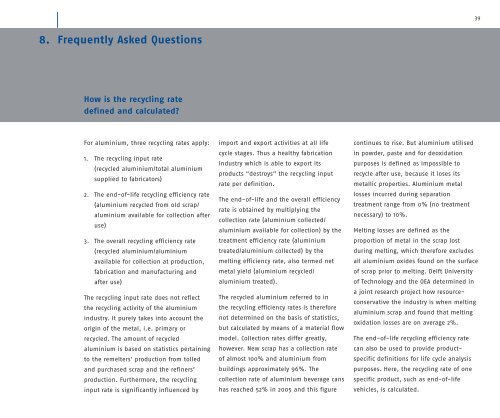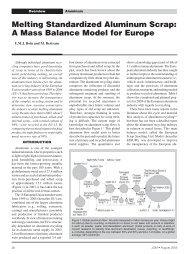Aluminium Recycling in Europe: the Road to High
Aluminium Recycling in Europe: the Road to High
Aluminium Recycling in Europe: the Road to High
You also want an ePaper? Increase the reach of your titles
YUMPU automatically turns print PDFs into web optimized ePapers that Google loves.
8. Frequently Asked Questions<br />
How is <strong>the</strong> recycl<strong>in</strong>g rate<br />
def<strong>in</strong>ed and calculated?<br />
For alum<strong>in</strong>ium, three recycl<strong>in</strong>g rates apply:<br />
1. The recycl<strong>in</strong>g <strong>in</strong>put rate<br />
(recycled alum<strong>in</strong>ium/<strong>to</strong>tal alum<strong>in</strong>ium<br />
supplied <strong>to</strong> fabrica<strong>to</strong>rs)<br />
2. The end-of-life recycl<strong>in</strong>g efficiency rate<br />
(alum<strong>in</strong>ium recycled from old scrap/<br />
alum<strong>in</strong>ium available for collection after<br />
use)<br />
3. The overall recycl<strong>in</strong>g efficiency rate<br />
(recycled alum<strong>in</strong>ium/alum<strong>in</strong>ium<br />
available for collection at production,<br />
fabrication and manufactur<strong>in</strong>g and<br />
after use)<br />
The recycl<strong>in</strong>g <strong>in</strong>put rate does not reflect<br />
<strong>the</strong> recycl<strong>in</strong>g activity of <strong>the</strong> alum<strong>in</strong>ium<br />
<strong>in</strong>dustry. It purely takes <strong>in</strong><strong>to</strong> account <strong>the</strong><br />
orig<strong>in</strong> of <strong>the</strong> metal, i.e. primary or<br />
recycled. The amount of recycled<br />
alum<strong>in</strong>ium is based on statistics perta<strong>in</strong><strong>in</strong>g<br />
<strong>to</strong> <strong>the</strong> remelters' production from <strong>to</strong>lled<br />
and purchased scrap and <strong>the</strong> ref<strong>in</strong>ers’<br />
production. Fur<strong>the</strong>rmore, <strong>the</strong> recycl<strong>in</strong>g<br />
<strong>in</strong>put rate is significantly <strong>in</strong>fluenced by<br />
import and export activities at all life<br />
cycle stages. Thus a healthy fabrication<br />
<strong>in</strong>dustry which is able <strong>to</strong> export its<br />
products “destroys” <strong>the</strong> recycl<strong>in</strong>g <strong>in</strong>put<br />
rate per def<strong>in</strong>ition.<br />
The end-of-life and <strong>the</strong> overall efficiency<br />
rate is obta<strong>in</strong>ed by multiply<strong>in</strong>g <strong>the</strong><br />
collection rate (alum<strong>in</strong>ium collected/<br />
alum<strong>in</strong>ium available for collection) by <strong>the</strong><br />
treatment efficiency rate (alum<strong>in</strong>ium<br />
treated/alum<strong>in</strong>ium collected) by <strong>the</strong><br />
melt<strong>in</strong>g efficiency rate, also termed net<br />
metal yield (alum<strong>in</strong>ium recycled/<br />
alum<strong>in</strong>ium treated).<br />
The recycled alum<strong>in</strong>ium referred <strong>to</strong> <strong>in</strong><br />
<strong>the</strong> recycl<strong>in</strong>g efficiency rates is <strong>the</strong>refore<br />
not determ<strong>in</strong>ed on <strong>the</strong> basis of statistics,<br />
but calculated by means of a material flow<br />
model. Collection rates differ greatly,<br />
however. New scrap has a collection rate<br />
of almost 100% and alum<strong>in</strong>ium from<br />
build<strong>in</strong>gs approximately 96%. The<br />
collection rate of alum<strong>in</strong>ium beverage cans<br />
has reached 52% <strong>in</strong> 2005 and this figure<br />
cont<strong>in</strong>ues <strong>to</strong> rise. But alum<strong>in</strong>ium utilised<br />
<strong>in</strong> powder, paste and for deoxidation<br />
purposes is def<strong>in</strong>ed as impossible <strong>to</strong><br />
recycle after use, because it loses its<br />
metallic properties. <strong>Alum<strong>in</strong>ium</strong> metal<br />
losses <strong>in</strong>curred dur<strong>in</strong>g separation<br />
treatment range from 0% (no treatment<br />
necessary) <strong>to</strong> 10%.<br />
Melt<strong>in</strong>g losses are def<strong>in</strong>ed as <strong>the</strong><br />
proportion of metal <strong>in</strong> <strong>the</strong> scrap lost<br />
dur<strong>in</strong>g melt<strong>in</strong>g, which <strong>the</strong>refore excludes<br />
all alum<strong>in</strong>ium oxides found on <strong>the</strong> surface<br />
of scrap prior <strong>to</strong> melt<strong>in</strong>g. Delft University<br />
of Technology and <strong>the</strong> OEA determ<strong>in</strong>ed <strong>in</strong><br />
a jo<strong>in</strong>t research project how resourceconservative<br />
<strong>the</strong> <strong>in</strong>dustry is when melt<strong>in</strong>g<br />
alum<strong>in</strong>ium scrap and found that melt<strong>in</strong>g<br />
oxidation losses are on average 2%.<br />
The end-of-life recycl<strong>in</strong>g efficiency rate<br />
can also be used <strong>to</strong> provide productspecific<br />
def<strong>in</strong>itions for life cycle analysis<br />
purposes. Here, <strong>the</strong> recycl<strong>in</strong>g rate of one<br />
specific product, such as end-of-life<br />
vehicles, is calculated.<br />
39



